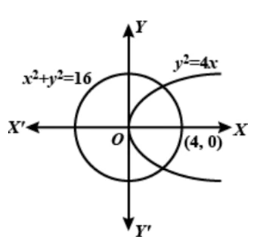
Find the number of points with integral coordinates that lie in the interior of the region common to circle $${x^2} + {y^2} = 16$$ and the parabola ${y^2} = 4x.$
A.8
B.10
C.16
D.None of these
Answer
605.4k+ views
Hint: We need to imagine the graphs of circle and parabola and the intersection of those two figures in a graph.
Let $\left( {\alpha ,\beta } \right)$ be the point with integral coordinates and lying in the interior of the region common to the circle ${x^2} + {y^2} = 16$ and the parabola ${y^2} = 4x.$
Then ${\alpha ^2} + {\beta ^2} - 16 < 0$ and ${\beta ^2} - 4\alpha < 0$

It is clear from the figure that $0 < \alpha < 4$ .
$ \Rightarrow \alpha = 1,2,3$ $\left[ {\because \alpha \in Z} \right]$
When $\alpha = 1$
${\beta ^2} < 4\alpha $
$ \Rightarrow {\beta ^2} < 4$
$ \Rightarrow \beta = 0,1$
So the points are (1, 0) and (1, 1).
When $\alpha = 2$
${\beta ^2} < 4\alpha $
$ \Rightarrow {\beta ^2} < 8$
$ \Rightarrow \beta = 0,1,2$
So the points are (2, 0), (2, 1) and (2, 2).
When $\alpha = 3$
${\beta ^2} < 4\alpha $
$ \Rightarrow {\beta ^2} < 12$
$ \Rightarrow \beta = 0,1,2,3$
So the points are (3, 0), (3, 1), (3, 2) and (3, 3)
Out of these four points (3, 3) does not satisfy ${\alpha ^2} + {\beta ^2} - 16 < 0$.
Thus, the points lying in the region are (1, 0), (1, 1), (2, 0), (2, 1), (2, 2), (3, 0), (3, 1) and (3, 2).
Note:
It is always better to start with the graph of given equations for these kinds of problems for better visualization.
Let $\left( {\alpha ,\beta } \right)$ be the point with integral coordinates and lying in the interior of the region common to the circle ${x^2} + {y^2} = 16$ and the parabola ${y^2} = 4x.$
Then ${\alpha ^2} + {\beta ^2} - 16 < 0$ and ${\beta ^2} - 4\alpha < 0$

It is clear from the figure that $0 < \alpha < 4$ .
$ \Rightarrow \alpha = 1,2,3$ $\left[ {\because \alpha \in Z} \right]$
When $\alpha = 1$
${\beta ^2} < 4\alpha $
$ \Rightarrow {\beta ^2} < 4$
$ \Rightarrow \beta = 0,1$
So the points are (1, 0) and (1, 1).
When $\alpha = 2$
${\beta ^2} < 4\alpha $
$ \Rightarrow {\beta ^2} < 8$
$ \Rightarrow \beta = 0,1,2$
So the points are (2, 0), (2, 1) and (2, 2).
When $\alpha = 3$
${\beta ^2} < 4\alpha $
$ \Rightarrow {\beta ^2} < 12$
$ \Rightarrow \beta = 0,1,2,3$
So the points are (3, 0), (3, 1), (3, 2) and (3, 3)
Out of these four points (3, 3) does not satisfy ${\alpha ^2} + {\beta ^2} - 16 < 0$.
Thus, the points lying in the region are (1, 0), (1, 1), (2, 0), (2, 1), (2, 2), (3, 0), (3, 1) and (3, 2).
Note:
It is always better to start with the graph of given equations for these kinds of problems for better visualization.
Recently Updated Pages
Master Class 12 Business Studies: Engaging Questions & Answers for Success

Master Class 12 Economics: Engaging Questions & Answers for Success

Master Class 12 English: Engaging Questions & Answers for Success

Master Class 12 Maths: Engaging Questions & Answers for Success

Master Class 12 Social Science: Engaging Questions & Answers for Success

Master Class 12 Chemistry: Engaging Questions & Answers for Success

Trending doubts
What is meant by exothermic and endothermic reactions class 11 chemistry CBSE

Which animal has three hearts class 11 biology CBSE

10 examples of friction in our daily life

One Metric ton is equal to kg A 10000 B 1000 C 100 class 11 physics CBSE

1 Quintal is equal to a 110 kg b 10 kg c 100kg d 1000 class 11 physics CBSE

Difference Between Prokaryotic Cells and Eukaryotic Cells




